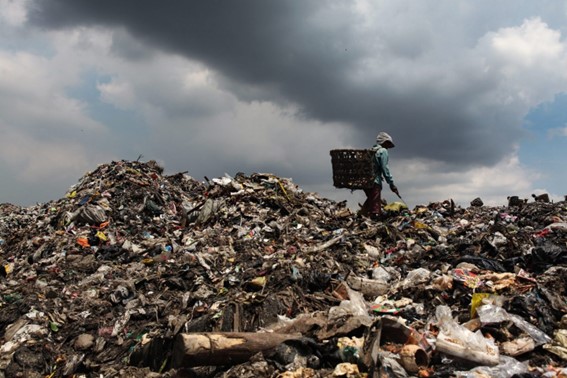
美國垃圾填埋場及其對環境造成的破壞規模龐大。目前大約有1200個垃圾填埋場在運營,平均每個填埋場占地約600英畝(約合2428112平方米),相當于480個足球場。
垃圾填埋場也是廢物的溫床,從腐爛的蔬菜殘渣、肉骨頭到破舊的家用電器,這些垃圾會產生大量的甲烷。這種溫室氣體在20年的時間里對全球氣候的變暖效應是二氧化碳的80倍。
發表在《科學》(Science)雜志上的一項新研究發現,垃圾填埋場的甲烷排放量是之前向聯邦監管機構報告的排放量的三倍。再加上甲烷的高效力,這項研究的發現提供了新證據(證據量在不斷增加),表明全球各地的垃圾填埋場是如何嚴重加劇全球變暖的,并強調了改革垃圾填埋場基礎設施和美國人處理垃圾方式的必要性。
這項研究使用了一種新技術——成像光譜儀,該儀器通過測量電磁輻射來探測和測量地球大氣的變化過程,收集了該國20%的大型垃圾填埋場的甲烷排放數據。在這項技術問世之前,對甲烷排放量的估算主要基于計算機模型,而根據這項研究,考慮到每個垃圾填埋場的獨特情況及其運營監督,這種模型并不理想。先前報告的甲烷排放量估計值可能低于實際值,原因是人工測量垃圾填埋場的排放量是極其危險的,需要工人帶著手持傳感器在垃圾場周圍走動。
垃圾填埋場通常堆放著一層又一層的垃圾,從腐爛的食物殘渣和塑料到家用電器和紙張,這些垃圾一堆就是幾十年。當食物垃圾最終被埋在這些垃圾層中時,它們會在沒有太多氧氣的情況下分解,從而釋放出甲烷。
該研究的主要作者、亞利桑那大學(University of Arizona)的氣候科學家丹尼爾·科斯沃思(Daniel Cusworth)說,“有時,垃圾填埋場下的垃圾一埋就是幾十年。”正如他在接受《紐約時報》采訪時所說,“我們稱之為垃圾千層面。”
在最常見的大氣溫室氣體中,甲烷并不是含量最大的,也不是在大氣中持續時間最長的,但其強大的變暖效應是最常見的溫室氣體二氧化碳的80倍。這意味著它會顯著加劇全球變暖,進而引發與氣候變化相關的事件,如強烈風暴、海平面上升、熱浪和干旱,而這些只是可能發生的災難的一部分。
在這項新研究中,科學家們利用飛機低空飛行和成像光譜儀收集數據,測量空氣中甲烷的濃度或羽流。2018年至2022年期間,飛機飛越了18個州和250多個垃圾填埋場。在調查的一半以上的垃圾填埋場中,研究人員發現了甲烷熱點,這表明填埋場出現了問題,比如長期埋藏的垃圾中有大量甲烷泄漏。
許多垃圾填埋場都有用來收集甲烷泄漏的井和管道,這些氣體有時會被收集起來燃燒發電或供熱。有了這項研究中使用的新技術,垃圾填埋場運營商和聯邦監管機構將更容易找到甲烷泄漏點并將其燃燒。
美國國家環境保護局(The Environmental Protection Agency)認為,垃圾填埋場是美國第三大人為甲烷污染源,到2022年,其排放量約占總排放量的14%,相當于2400萬輛汽車的年排放量。根據海洋和大氣研究組織(Oceanic and Atmospheric Research,研究影響地球的系統的組織)的數據,目前大氣中的甲烷的含量(以十億分之一為單位)比工業化前的水平高出160%以上。
高水平的甲烷會導致與氣候有關的災難,同時也會給生活在垃圾填埋場附近的野生動物和家庭帶來健康風險,包括氣味、煙塵、煙霧和水源污染。更糟糕的是,那些生活在低收入地區的人最有可能承受這些風險,而且他們沒有足夠的財力反對垃圾填埋設施的建設。
誠然,垃圾填埋場改革是當務之急,但改變人們處理廚余垃圾的方式也能有效減少垃圾填埋場的甲烷排放。例如,經過堆肥處理的廚余垃圾會進行好氧或有氧分解,由于氧氣的存在,這一過程不會釋放甲烷。
垃圾填埋場、農業、石油和天然氣生產等行業是甲烷排放量最大的行業,近年來一直受到科學家和環保人士的密切關注。化石燃料研究和倡導組織國際石油變革組織(Oil Change International)最近研究了美國和歐洲八大國際石油和天然氣生產商的氣候計劃和承諾,發現這些計劃都與將全球升溫控制在比工業化前水平高1.5攝氏度的范圍內的目標不一致。科學家警告說,一旦突破這一門檻,將會產生災難性的后果。(財富中文網)
譯者:中慧言-王芳
美國垃圾填埋場及其對環境造成的破壞規模龐大。目前大約有1200個垃圾填埋場在運營,平均每個填埋場占地約600英畝(約合2428112平方米),相當于480個足球場。
垃圾填埋場也是廢物的溫床,從腐爛的蔬菜殘渣、肉骨頭到破舊的家用電器,這些垃圾會產生大量的甲烷。這種溫室氣體在20年的時間里對全球氣候的變暖效應是二氧化碳的80倍。
發表在《科學》(Science)雜志上的一項新研究發現,垃圾填埋場的甲烷排放量是之前向聯邦監管機構報告的排放量的三倍。再加上甲烷的高效力,這項研究的發現提供了新證據(證據量在不斷增加),表明全球各地的垃圾填埋場是如何嚴重加劇全球變暖的,并強調了改革垃圾填埋場基礎設施和美國人處理垃圾方式的必要性。
這項研究使用了一種新技術——成像光譜儀,該儀器通過測量電磁輻射來探測和測量地球大氣的變化過程,收集了該國20%的大型垃圾填埋場的甲烷排放數據。在這項技術問世之前,對甲烷排放量的估算主要基于計算機模型,而根據這項研究,考慮到每個垃圾填埋場的獨特情況及其運營監督,這種模型并不理想。先前報告的甲烷排放量估計值可能低于實際值,原因是人工測量垃圾填埋場的排放量是極其危險的,需要工人帶著手持傳感器在垃圾場周圍走動。
垃圾填埋場通常堆放著一層又一層的垃圾,從腐爛的食物殘渣和塑料到家用電器和紙張,這些垃圾一堆就是幾十年。當食物垃圾最終被埋在這些垃圾層中時,它們會在沒有太多氧氣的情況下分解,從而釋放出甲烷。
該研究的主要作者、亞利桑那大學(University of Arizona)的氣候科學家丹尼爾·科斯沃思(Daniel Cusworth)說,“有時,垃圾填埋場下的垃圾一埋就是幾十年。”正如他在接受《紐約時報》采訪時所說,“我們稱之為垃圾千層面。”
在最常見的大氣溫室氣體中,甲烷并不是含量最大的,也不是在大氣中持續時間最長的,但其強大的變暖效應是最常見的溫室氣體二氧化碳的80倍。這意味著它會顯著加劇全球變暖,進而引發與氣候變化相關的事件,如強烈風暴、海平面上升、熱浪和干旱,而這些只是可能發生的災難的一部分。
在這項新研究中,科學家們利用飛機低空飛行和成像光譜儀收集數據,測量空氣中甲烷的濃度或羽流。2018年至2022年期間,飛機飛越了18個州和250多個垃圾填埋場。在調查的一半以上的垃圾填埋場中,研究人員發現了甲烷熱點,這表明填埋場出現了問題,比如長期埋藏的垃圾中有大量甲烷泄漏。
許多垃圾填埋場都有用來收集甲烷泄漏的井和管道,這些氣體有時會被收集起來燃燒發電或供熱。有了這項研究中使用的新技術,垃圾填埋場運營商和聯邦監管機構將更容易找到甲烷泄漏點并將其燃燒。
美國國家環境保護局(The Environmental Protection Agency)認為,垃圾填埋場是美國第三大人為甲烷污染源,到2022年,其排放量約占總排放量的14%,相當于2400萬輛汽車的年排放量。根據海洋和大氣研究組織(Oceanic and Atmospheric Research,研究影響地球的系統的組織)的數據,目前大氣中的甲烷的含量(以十億分之一為單位)比工業化前的水平高出160%以上。
高水平的甲烷會導致與氣候有關的災難,同時也會給生活在垃圾填埋場附近的野生動物和家庭帶來健康風險,包括氣味、煙塵、煙霧和水源污染。更糟糕的是,那些生活在低收入地區的人最有可能承受這些風險,而且他們沒有足夠的財力反對垃圾填埋設施的建設。
誠然,垃圾填埋場改革是當務之急,但改變人們處理廚余垃圾的方式也能有效減少垃圾填埋場的甲烷排放。例如,經過堆肥處理的廚余垃圾會進行好氧或有氧分解,由于氧氣的存在,這一過程不會釋放甲烷。
垃圾填埋場、農業、石油和天然氣生產等行業是甲烷排放量最大的行業,近年來一直受到科學家和環保人士的密切關注。化石燃料研究和倡導組織國際石油變革組織(Oil Change International)最近研究了美國和歐洲八大國際石油和天然氣生產商的氣候計劃和承諾,發現這些計劃都與將全球升溫控制在比工業化前水平高1.5攝氏度的范圍內的目標不一致。科學家警告說,一旦突破這一門檻,將會產生災難性的后果。(財富中文網)
譯者:中慧言-王芳
YUNAIDI JOEPOET—GETTY IMAGES
America’s landfills—and the environmental havoc they create—are sizable. There are roughly 1,200 landfills currently in operation, and on average, each one takes up about 600 acres of land, the equivalent of 480 football fields.
Landfills are also a hotbed for waste, from decomposing vegetable scraps and meat bones to worn household appliances, which produce copious amounts of methane, a greenhouse gas with a warming effect 80 times as powerful as carbon dioxide over a 20-year period.
A new study published in the journal Science found the rate of methane emissions from landfills is three times as large as the rate previously reported to federal regulators. In combination with methane’s high potency, the study’s findings add to a growing body of evidence about how landfills around the globe significantly contribute to global warming and highlight the need for reforms, both in the infrastructure of landfills and the way Americans dispose of waste.
The study used a new technology, an imaging spectrometer, which measures electromagnetic radiation to detect and measure processes in the Earth’s atmosphere, to collect data on methane emissions from 20% of the country’s largest landfills. Before the advent of this technology, estimates of methane emissions were based mostly on computer models, which, according to the study, are less than optimal, given the unique circumstances of each landfill and its operational oversight. Previously reported methane emission estimates are also likely lower than reality, as a result of the dangerous nature of manually measuring emissions at landfills, which require workers to walk around dumps with handheld sensors.
Landfills often contain layers upon layers of garbage, encompassing everything from decomposing food scraps and plastic to household appliances and paper, that pile up for decades. When food waste ends up buried in these layers, it decomposes without much oxygen and, as a result, releases methane.
“You can sometimes get decades of trash that’s sitting under the landfill,” according to Daniel Cusworth, the lead author of the study and a climate scientist at the University of Arizona. As he told the New York Times, “We call it a garbage lasagna.”
Among the most common atmospheric greenhouse gases, methane isn’t the most abundant or the longest-lasting in the atmosphere, but its potent warming effect is 80 times as powerful as the most common greenhouse gas, carbon dioxide. That means it can significantly contribute to global warming, and in turn, spur climate-change–related events, such as intense storms, rising sea levels, heat waves, and drought, which are just some of the catastrophes that can occur.
In the new study, scientists collected data using airplane flyovers and imaging spectrometers to measure concentrations, or plumes, of methane in the air. Planes flew across 18 states and over 250 landfill sites between 2018 and 2022. At more than half of the landfills surveyed, researchers detected methane hotspots that suggest something had gone wrong at the site, like a big methane leak from long-buried trash.
Many landfills contain wells and pipes meant to capture methane leaks, and the gases are sometimes then collected and burned to produce electricity or heat. With the new technology used in the study, landfill operators and federal regulators will more easily be able to pinpoint and flare methane leaks.
The Environmental Protection Agency considers landfills to be the third-largest source of human-caused methane pollution in the country, accounting for roughly 14% of these emissions in 2022 and equal to the yearly emissions of 24 million cars. Atmospheric levels of methane, which is measured in parts per billion, are now more than 160% higher than preindustrial levels, according to Oceanic and Atmospheric Research, a group that investigates systems affecting the planet.
The high levels of methane will contribute to climate-related disasters while also posing health risks to wildlife and families who live near landfills, including odors, smoke, smog, and water-supply contamination. What’s worse is those living in low-income areas are most likely to live with those risks, and have fewer financial resources to oppose the placement of waste facilities.
To be sure, landfill reforms are a pressing need—but changes in how people dispose of food waste can also be impactful in reducing methane emissions at waste sites. Food waste that is composted, for example, undergoes an aerobic, or oxygenated, decomposition, a process that doesn’t release methane owing to the presence of oxygen.
Industries like landfills, agriculture, and oil and gas production are among the sectors that emit the most methane, and have been under intense scrutiny by scientists and environmental activists in recent years. Oil Change International, a fossil fuel research and advocacy group, recently examined climate plans and pledges from the eight largest U.S.- and European-based international oil and gas producers, and found that none of the plans were compatible with limiting global warming to 1.5 degrees Celsius above preindustrial levels—a threshold scientists warn will have disastrous effects when breached.






